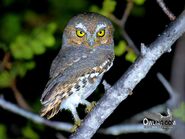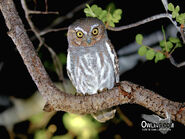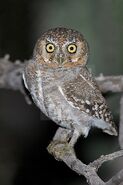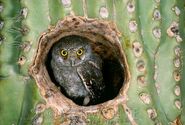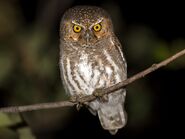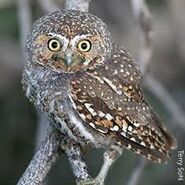 This article is a stub. You can help the Guardians of Ga'Hoole Wiki by expanding it.
This article is a stub. You can help the Guardians of Ga'Hoole Wiki by expanding it.
Elf Owls (Micrathene whitneyi) are a very small species of owl. They are known to dwell in cacti in the Desert of Kuneer.
Information[]
Description[]
Elf Owls are the world's smallest owl at 5-6 in (13-14 cm) long, and with a wingspan of about 11 in (27 cm). They are also the world's lightest owl at 1-1.7 oz (30-48 g). Elf Owls do not have "ear tufts" or feathers on the top of their rounded heads. Their feathers are grayish brown in color. Their eyes are pale yellow and are highlighted by thin white "eyebrows". The bill is gray with a horn-colored tip. Their legs are fairly long and they stand bow-legged.
Elf Owls, like other owls have excellent night vision. They can't see in complete darkness, but they can see quite well in low-light. They also have excellent hearing. They can catch their prey in complete darkness, by pinpointing it using their ears rather than eyes. Elf Owls have "silent flight" which means they don't make any noise as they approach their prey. The sound of their wing beat is muffled by softened feathers on the leading edges of their wings.
Their primary call is a high-pitched "whi-whi-whi-whi-whi".
Ecology[]
Elf Owls are found mainly in mesquite or deciduous riparian habitats (places where there is water), or in desert areas where saguaro cactus are plentiful.
When captured, this tiny owl will play dead until all danger has passed. They are not very aggressive, preferring to fly away rather than fight. Elf owl predators can include other owls, snakes, coyotes, bobcats and ringtail. Most predators find it difficult to access the owls nest high up in a saguaro.
Elf Owls are found from the southwest USA to Central Mexico and Baja California. Northern populations winter in Central Mexico and on the Pacific slope north to Sinaloa, Mexico.
The most important threat to the elf owl is habitat loss both of its riparian forest habitat and desert-scrub habitats. In Arizona, the elf owl is not uncommon, but it's numbers are decreasing in California and Texas.
Because it can be too cold in the desert for many nocturnal insects, the elf owl will migrate to Mexico during the winter. They usually stay in breeding pairs, but during migration or when mobbing predators, they will fly in small groups.
Diet[]
They feed primarily on invertebrates such as moths, crickets, scorpions, centipedes and beetles. They may also prey on small mammals like kangaroo rats, and reptiles like spiny lizards, earless lizards, and blind snakes.
Most prey is captured in flight. They are sometimes attracted to fires and lights to catch insects.
Reproduction[]
They are fiercely territorial, with the territory established by the male and defended by both the male and female. They are monogamous.
Elf owls nest in natural tree cavities and abandoned woodpecker holes that can be found in giant cacti, oak trees, and sycamores. The nests are about 15 to 35 feet from the ground. The female elf owl will lay 1-5 white eggs, incubation last about 24 days, fledging begins after about 10 weeks.
In the wild, elf owls live 3-6 years. In captivity they usually live longer, between 6-10 years.
Significant Elf Owls[]
History[]
The Capture[]
This section is unfinished. You can help the wiki by writing an entry.
The Journey[]
This section is unfinished. You can help the wiki by writing an entry.
The Rescue[]
This section is unfinished. You can help the wiki by writing an entry.
The Siege[]
This section is unfinished. You can help the wiki by writing an entry.
The Shattering[]
This section is unfinished. You can help the wiki by writing an entry.
The Burning[]
This section is unfinished. You can help the wiki by writing an entry.
The Outcast[]
Gylfie was present with the rest of the Chaw of Chaws, save for Otulissa, to witness the passing of Boron and Barran. Later, when Coryn arrived at the Tree, he asked if he might call her Aunt Gylfie, to which she happily agreed.
The First Collier[]
Gylfie was waiting outside Ezylryb's hollow along with Digger and Twilight.
The Coming of Hoole[]
Gylfie, Digger, Twilight, and Otulissa ask to read the The Legends of Ga'Hoole. Coryn and Soren agree that they should.
To Be a King[]
Gylfie, perched on Twilight's shoulder, joined the others in reading the final legend. Afterwards, Gylfie assures Coryn that he has the character to resist the bad influences of the Ember.
The Golden Tree[]
This section is unfinished. You can help the wiki by writing an entry.
The River of Wind[]
This section is unfinished. You can help the wiki by writing an entry.
Exile[]
This section is unfinished. You can help the wiki by writing an entry.
The War of the Ember[]
This section is unfinished. You can help the wiki by writing an entry.
A Guide Book to the Great Tree[]
This section is unfinished. You can help the wiki by writing an entry.
The Rise of a Legend[]
This section is unfinished. You can help the wiki by writing an entry.
Trivia[]
- Their genus name Micrathene combines the Ancient Greek mikros (small) with the genus name Athene (after the Greek goddess Athena).
- Their species name whitneyi is a Latinized form of the last name of the American geologist Josiah Dwight Whitney. Because of this, it was originally known as Whitney's Owl.


